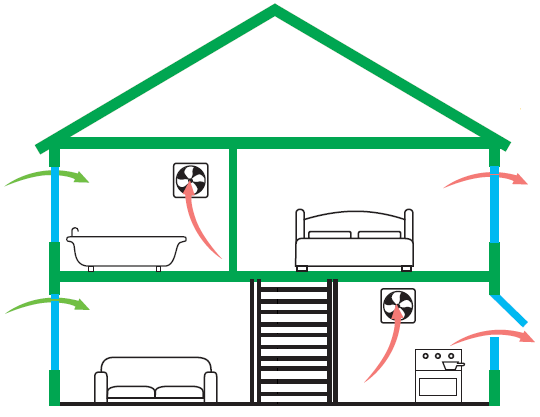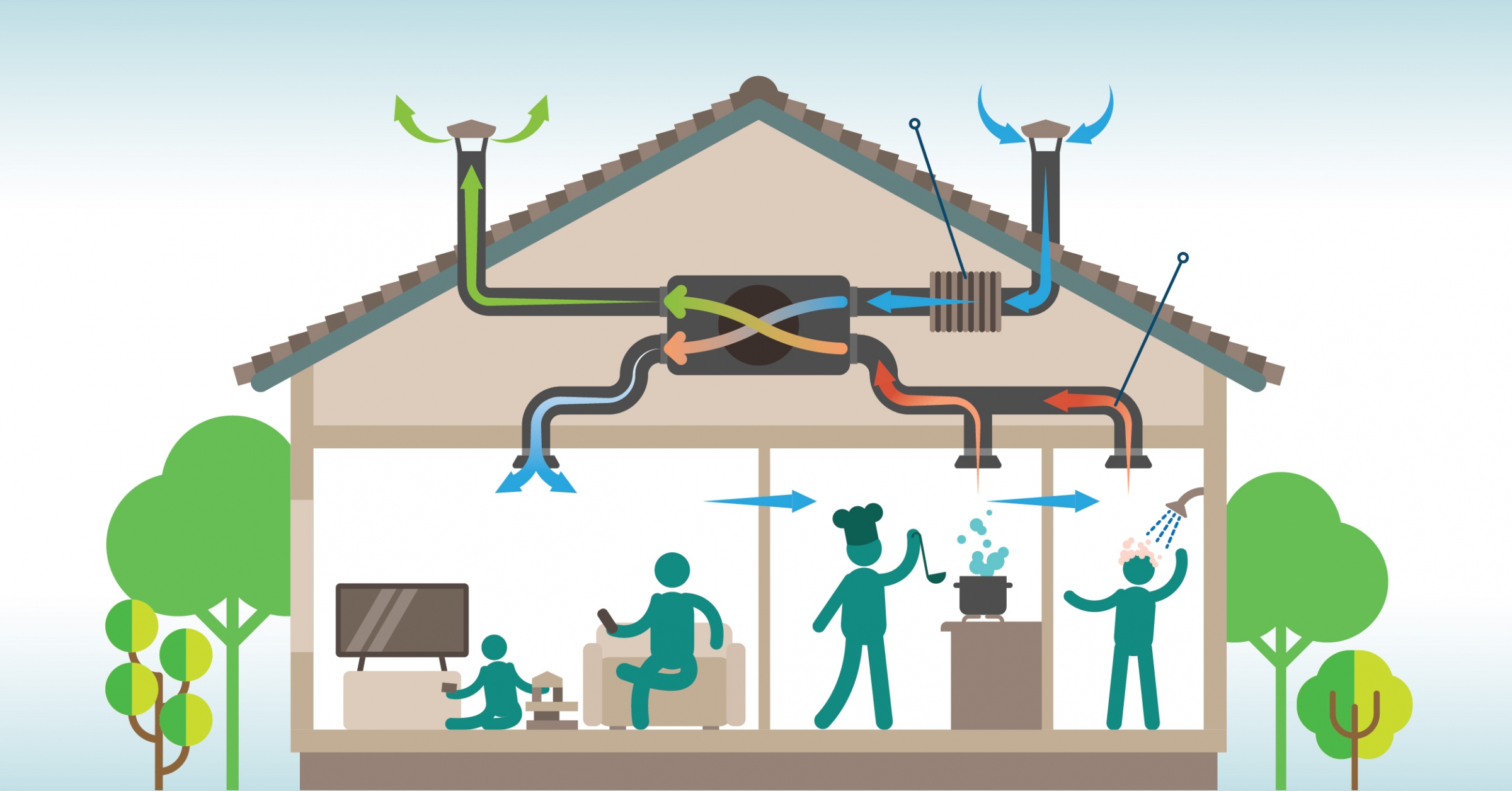Comprehending the Value of Home Air Flow for a Healthier Living Atmosphere
Home ventilation plays an essential role in keeping a healthy and balanced living setting. It facilitates the exchange of indoor and exterior air, which is necessary for enhancing air high quality. Without correct ventilation, homes can become breeding premises for pollutants and allergens. The consequences of inadequate air flow can be significant. This raises the questions of exactly how property owners can successfully implement ventilation techniques to secure their wellness and wellness. Comprehending these techniques is critical.

The Essentials of Home Ventilation
Home air flow works as a crucial component of indoor air quality and comfort. It includes the process of exchanging stale indoor air with fresh outdoor air, thus decreasing humidity and controlling temperature. Proper ventilation systems can consist of all-natural techniques, such as open windows and vents, as well as mechanical systems, such as exhaust followers and air exchangers. Efficient home air flow assists protect against concerns like interior mold and mildew growth and the buildup of dangerous bits. It additionally improves total energy efficiency, as well-ventilated areas can maintain comfy temperature levels with much less reliance on home heating and cooling systems. Understanding the basics of home air flow is crucial for house owners seeking to develop a healthier living atmosphere for themselves and their family members.

Usual Sources of Indoor Air Contamination

Although lots of may not understand it, indoor air pollution can stem from numerous sources within a home. Common contributors include unpredictable natural substances (VOCs) given off from paints, solvents, and cleaning items. Family home appliances, such as gas ovens and fire places, can release harmful gases like carbon monoxide gas and nitrogen dioxide. Furthermore, mold and mold prosper in damp locations, launching spores that influence air high quality. Animal dander, dirt mites, and pollen can accumulate inside, additional exacerbating air pollution levels. Smoking inside produces toxic chemicals that remain airborne. Finally, constructing materials, consisting of asbestos and formaldehyde, can off-gas dangerous compounds. Acknowledging these resources is vital for keeping a healthier interior setting and promoting efficient air flow methods.
Wellness Results of Poor Ventilation
Interior air pollution can have substantial health and wellness effects, especially when air flow is inadequate. Poor ventilation can bring about the build-up of damaging toxins, such as volatile organic substances, mold, and particulate matter. This build-up might cause breathing concerns, consisting of asthma, allergies, and chronic obstructive lung condition. Individuals may experience symptoms like frustrations, exhaustion, and irritation of the eyes, nose, and throat. Susceptible populations, such as children and the senior, go to greater threat for severe health and wellness results. Long-term exposure to poorly ventilated settings can additionally add to more serious conditions, consisting of cardio illness. Consequently, guaranteeing correct air flow is important for preserving a healthy living setting and reducing the threat of health and wellness issues related to interior air pollution.
Reliable Ventilation Techniques for Your Home
Proper air flow is vital for maintaining a healthy and balanced indoor environment, and applying effective approaches can substantially enhance air quality. House owners can start by making sure that exhaust followers are mounted in washrooms and kitchen areas to get rid of excess dampness and odors. Opening up home windows on a regular basis allows fresh air to flow, especially during light weather. Furthermore, making use of air purifiers with HEPA filters can aid capture airborne contaminants. For homes with home heating and cooling down systems, maintaining cooling and heating systems and altering filters consistently is important for peak efficiency. Including natural ventilation strategies, such as cross-ventilation, can additionally improve air movement. Lastly, securing any leaks in home windows and doors stops unwanted drafts, which can interrupt controlled airflow, inevitably resulting in enhanced interior air high quality and convenience.
Preserving Optimum Air Top Quality Year-Round
To keep perfect air high quality year-round, home owners should embrace a positive technique to handling their interior setting. Routinely keeping an eye on interior air high quality is important; this includes monitoring for contaminants such as dust, mold and mildew, and unstable organic compounds (VOCs) Executing effective air flow systems, such as exhaust fans and air purifiers, can greatly reduce air-borne pollutants. In addition, regular maintenance of HVAC systems warranties peak performance and air blood circulation. House owners must also consider moisture degrees, as extreme moisture can lead to mold and mildew development. Seasonal modifications may necessitate adjustments in ventilation techniques to suit differing outdoor air top quality. By prioritizing these methods, property owners can see this website create a much healthier space, advertising general well-being for all passengers throughout the year.
Often Asked Inquiries
Exactly How Can I Tell if My Home Demands Better Air Flow?
To identify if a home calls for far better ventilation, one need to observe indications such as relentless humidity, mold and mildew growth, musty odors, condensation on home windows, or boosted allergy signs and symptoms, suggesting poor airflow and potentially inadequate indoor air high quality.
What Are the Indicators of Poor Indoor Air Quality?

Can Houseplants Improve Indoor Air Quality Properly?
The efficiency of houseplants in boosting indoor air high quality is discussed. While some researches suggest they can soak up toxins and create oxygen, their overall effect might be very little contrasted to additional reading proper air flow and air filtration systems.
Exactly how Frequently Should I Adjustment My Air Filters?
The regularity of air filter modifications generally depends upon use and filter type. Typically, it is recommended to replace filters every 3 months, though houses with animals or allergic look at these guys reactions might require more regular adjustments for perfect performance.
Are There Any Kind Of Particular Air Flow Equipments for Allergy Sufferers?
Numerous ventilation systems, such as HEPA-filtered systems, effectively decrease allergens in the air. Home Ventilation Melbourne. These systems trap pollen, animal, and dust dander, supplying allergy patients with a cleaner, much healthier interior atmosphere while handling air quality successfully
It assists in the exchange of interior and outside air, which is crucial for enhancing air high quality. Home ventilation serves as a necessary component of interior air top quality and convenience. It includes the process of trading stagnant interior air with fresh outside air, thus decreasing moisture and managing temperature. Interior air contamination can have substantial health implications, especially when ventilation is inadequate. Appropriate air flow is crucial for preserving a healthy interior setting, and carrying out effective strategies can greatly boost air top quality.